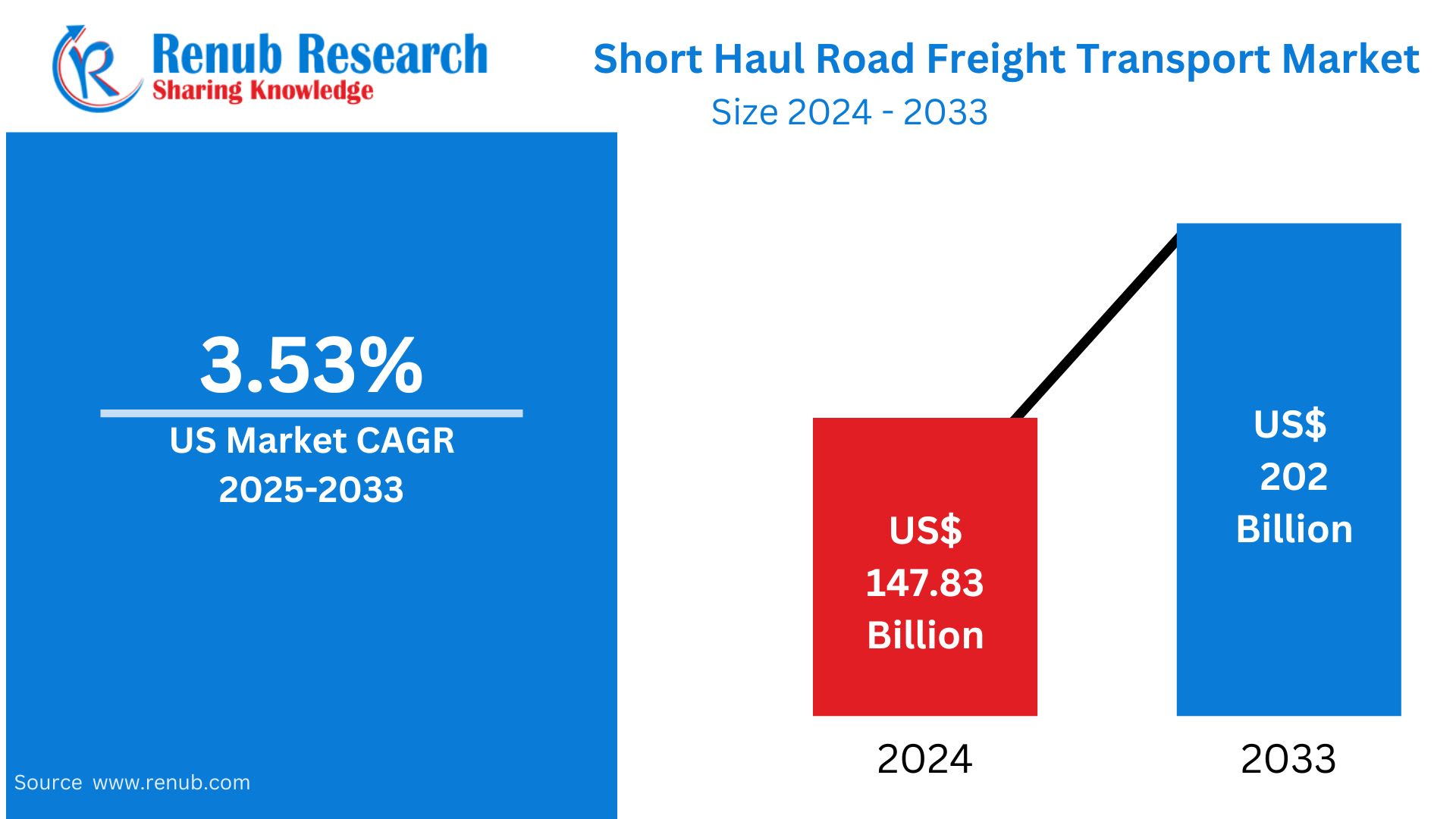The United States Short Haul Road Freight Transport Market is on a steady upward trajectory, powered by the nation’s thriving e-commerce ecosystem, expanding manufacturing activities, and rapid advances in fleet management technologies. According to Renub Research, the market is expected to reach US$ 202 billion by 2033, rising from US$ 147.83 billion in 2024, growing at a CAGR of 3.53% from 2025 to 2033. This sustained demand reflects the critical role that short-distance freight plays in supporting modern supply chains, last-mile delivery, and urban logistics across the U.S.
Short haul road freight—typically involving distances under 300 miles—serves as the backbone of regional distribution networks. Whether it’s replenishing retail shelves, transporting food products, or delivering online orders to customers’ doorsteps, this segment ensures speed, flexibility, and operational continuity for businesses nationwide.
In this editorial, we explore the market dynamics, growth drivers, regional outlook, challenges, and recent developments that define the rapidly evolving U.S. short haul freight landscape.
United States Short Haul Road Freight Transport Industry Overview
Short haul road freight transport includes the movement of goods within limited geographic areas, often between neighboring towns, ports, warehouses, retail stores, and urban centers. It is particularly essential for:
Last-mile delivery
Perishable and non-perishable goods distribution
Just-in-time (JIT) inventory systems
Urban and suburban freight movement
The industry relies primarily on light commercial vehicles (LCVs), heavy commercial vehicles (HCVs), vans, and regional trucks, providing cost-efficient and fast transport solutions. Compared to long-haul trucking, short haul operations prioritize speed, agility, and high-frequency delivery cycles—critical elements for e-commerce, grocery distribution, pharmaceuticals, and FMCG companies.
As U.S. cities expand and consumer expectations for rapid delivery grow, short haul freight has become the nerve center of regional logistics. The rise of micro-fulfillment centers, on-demand delivery, and nearshoring manufacturing further deepens its relevance in America’s supply chain ecosystem.
Key Growth Drivers in the U.S. Short Haul Road Freight Transport Market
1. Explosive E-Commerce Growth
The continued rise of e-commerce is the single largest catalyst for short haul freight expansion. Online shoppers today expect fast, reliable, and flexible delivery options—ranging from same-day to next-day services. This trend requires a dense network of regional warehouses, micro-hubs, and fulfillment centers, all of which depend heavily on short haul transportation.
Promotional events, flash sales, and seasonal peaks amplify demand for frequent, route-optimized local deliveries. Retailers and logistics companies are expanding local distribution hubs to accelerate click-to-door speed, making short haul freight indispensable to maintaining customer satisfaction.
2. Technological Advancements and Digital Transformation
Technology is reshaping short haul logistics more rapidly than ever. Tools such as:
Fleet telematics
AI-based route optimization
GPS-enabled real-time tracking
Warehouse automation
Predictive analytics
are helping logistics companies cut fuel costs, enhance visibility, and reduce delivery times.
A landmark development occurred in September 2024, when FedEx partnered with Nimble, an AI robotics and autonomous fulfillment innovator, to enhance its omnichannel operations. FedEx’s extensive network—spanning over 130 warehouse facilities and processing 475 million returns annually—now uses Nimble’s autonomous tech to streamline local logistics, reinforcing the importance of digitally enabled short haul operations.
3. Growth of Just-in-Time (JIT) Inventory Systems
JIT inventory practices minimize storage costs and ensure goods are replenished only when needed. This increases the frequency of short haul deliveries across industries such as:
Automotive
Electronics
Retail
FMCG
Short haul freight plays a crucial role in JIT operations by enabling rapid movement between production sites, warehouses, and retail outlets. As more U.S. companies shift toward lean supply chain operations, the demand for flexible, reliable short haul services continues to grow.
Challenges Facing the U.S. Short Haul Road Freight Market
1. Rising Fuel Costs
Fuel remains a major operational expense for freight carriers. Short haul operations—characterized by frequent stops, idling in congested traffic, and lower fuel efficiency—are particularly vulnerable to fuel price volatility. Smaller operators face tighter margins and limited capital for fleet upgrades, making cost pressures even more significant.
While many companies are adopting fuel-efficient vehicles, electric fleets, and route optimization tools, volatile fuel prices continue to challenge overall profitability.
2. Congestion and Urban Delivery Restrictions
Urbanization is increasing, and so are the challenges associated with last-mile delivery:
Traffic congestion
Limited parking spaces
Strict delivery time windows
Low-emission zones
Vehicle size restrictions
Metropolitan areas like New York, Chicago, and Los Angeles enforce stringent policies that complicate route planning and raise delivery costs. To navigate these constraints, companies are turning to smaller vehicles, EVs, and advanced telematics—yet congestion remains a persistent bottleneck in short haul operations.
Regional Insights: Key U.S. States Driving Market Growth
1. California
As the nation’s most populous state, California is a vital hub for short haul logistics. With bustling cities such as Los Angeles, San Diego, and San Francisco, the state sees massive e-commerce-driven last-mile volumes. Its strong manufacturing, agriculture, and technology sectors further fuel demand.
However, California also presents challenges:
Severe urban congestion
Strict environmental regulations
Limited delivery windows
Companies are increasingly adopting electric trucks, innovative routing tools, and sustainable practices to remain compliant and competitive.
2. Texas
Texas’ vast land area and powerful industrial base make it a cornerstone of short haul road freight. Major metro regions—including Houston, Dallas, Austin, and San Antonio—generate strong demand in:
E-commerce
Retail
Energy and petrochemicals
Agriculture
The state’s expanding highway network supports efficient short haul movement, though long distances between cities and urban congestion pose operational challenges. Texas’ fast-growing population and business-friendly environment are expected to sustain market growth through 2033.
3. New York
New York’s dense urban population and high consumer demand make it a highly lucrative yet challenging short haul market. The New York City metro area drives enormous last-mile logistics needs across:
Retail & fashion
Food and beverages
Healthcare
E-commerce
Severe traffic congestion, strict regulations, and parking constraints create complexities for carriers. Logistics companies are increasingly investing in smaller delivery vehicles, electric fleets, and micro-fulfillment centers to manage intense urban delivery volumes.
4. Florida
Florida’s booming tourism industry, rapid population growth, and expanding retail sector fuel strong demand for short haul transport. Cities such as Miami, Orlando, and Tampa require consistent regional deliveries of:
Perishable goods
Pharmaceuticals
Consumer products
Weather-related challenges, such as hurricanes and seasonal fluctuations, impact operations. However, the state’s strategic ports and advancement in telematics tools are supporting growth in efficient short haul logistics.
Recent Developments Transforming the U.S. Short Haul Freight Market
August 2024 – FedEx Innovation in Digital Visibility
FedEx introduced advanced digital visibility tools that integrate real-time shipment data, predictive analytics, and premium post-purchase tracking. This innovation allows businesses to better manage delivery experiences and optimize logistics operations through:
Track API
Track EDI
Webhook subscription services
These upgrades strengthen FedEx’s capabilities in regional and last-mile logistics.
August 2024 – CEVA Logistics & Bolloré Logistics Integration
CEVA and Bolloré Logistics began operating under a consolidated brand. This union enhances CEVA’s footprint in multimodal logistics, including ground and road transport. The integration, supported by the implementation of CargoWise, is expected to elevate operational efficiency across short haul networks in the U.S.
Market Segments
Vehicle Type
Light Commercial Vehicles (LCVs)
Heavy Commercial Vehicles (HCVs)
Destination
Domestic
International
End-Use Applications
Manufacturing
Retail
Wholesale
Construction
Agriculture
Fishing & Forestry
Oil & Gas
Mining & Quarrying
Others
Distribution Channels
Home Centers
Specialty Stores
Online Channels
Hypermarkets & Warehouse Clubs
Others
State Coverage (29 Viewpoints)
Includes major states such as:
California, Texas, New York, Florida, Illinois, Pennsylvania, Ohio, Georgia, New Jersey, Washington, North Carolina, Massachusetts, Virginia, Michigan, Maryland, Colorado, Tennessee, Indiana, Arizona, Minnesota, Wisconsin, Missouri, Connecticut, South Carolina, Oregon, Louisiana, Alabama, Kentucky, and the Rest of the U.S.
Key Players in the U.S. Short Haul Road Freight Market
Schneider National, Inc.
DHL Group
FedEx
United Parcel Service of America, Inc. (UPS)
XPO, Inc.
Landstar System Inc.
PS Logistics
Knight-Swift Transportation Holdings Inc.
Ryder System, Inc.
These companies focus on technology adoption, operational optimization, network expansion, and sustainability to maintain competitiveness in a fast-evolving logistics landscape.
Final Thoughts
The United States Short Haul Road Freight Transport Market is entering a new era, shaped by digital transformation, evolving consumer expectations, and strategic infrastructure development. With the market projected to reach US$ 202 billion by 2033, short haul freight will continue to be a cornerstone of America’s logistics ecosystem.
From e-commerce acceleration to state-level innovations and the rise of electric vehicle fleets, the sector is set for steady, technology-driven expansion. Companies that invest in automation, sustainability, and dynamic route optimization will be best positioned to thrive in this competitive landscape.








